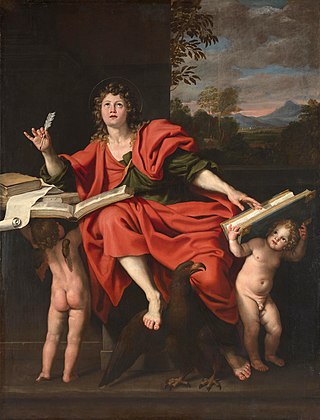
The Book of Revelation, also erroneously called the Book of Revelations, is the final book of the New Testament. Written in Koine Greek, its title is derived from the first word of the text: apokalypsis, meaning 'unveiling' or 'revelation'. The Book of Revelation is the only apocalyptic book in the New Testament canon. It occupies a central place in Christian eschatology.

The living creatures, living beings, or hayyot are a class of heavenly beings in Jewish mythology. They are described in the prophet Ezekiel's vision of the heavenly chariot in the first and tenth chapters of the Book of Ezekiel. References to the sacred creatures recur in texts of Second Temple Judaism, in rabbinical merkabah ("chariot") literature, in the Book of Revelation in the Christian New Testament, and in the Zohar.

In Jainism, a Tirthankara is a saviour and spiritual teacher of the dharma. The word tirthankara signifies the founder of a tirtha, which is a fordable passage across the sea of interminable births and deaths, the saṃsāra. According to Jains, tirthankaras are the supreme preachers of dharma, who have conquered the saṃsāra, the cycle of death and rebirth, on their own, and made a path for others to follow. After understanding the true nature of the self or soul, the Tīrthaṅkara attains kevala jnana (omniscience). A Tirthankara provides a bridge for others to follow the new teacher from saṃsāra to moksha (liberation).
In Jainism, godliness is said to be the inherent quality of every soul. This quality, however, is subdued by the soul's association with karmic matter. All souls who have achieved the natural state of infinite bliss, infinite knowledge, infinite power and infinite perception are regarded as God in Jainism. Jainism rejects the idea of a creator deity responsible for the manifestation, creation, or maintenance of this universe. Instead, souls who have reached Heaven for their merits and deeds influence the Universe for a fixed period until they undergo reincarnation and continue the cycle of enlightenment. According to Jain doctrine, the universe and its constituents have always existed. All constituents and actions are governed by universal natural laws and "perfect soul".
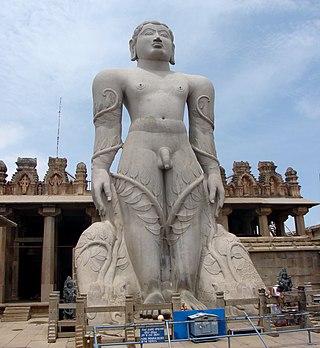
Bahubali, a much revered figure among Jains, was the son of Rishabadeva and the brother of Bharata Chakravartin. He is said to have meditated motionless for a 12 years in a standing posture (kayotsarga) and that during this time, climbing plants grew around his legs. After his 12 year of meditation, Bahubali is said to have attained omniscience.

The events of Revelation are the events that occur in the Book of Revelation of the New Testament. An outline follows below, chapter by chapter.
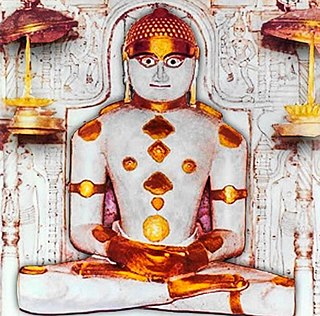
Rishabhanatha, also Rishabhadeva, Rishabha or Ikshvaku is the first tirthankara of Jainism. He was the first of twenty-four teachers in the present half-cycle of time in Jain cosmology, and called a "ford maker" because his teachings helped one cross the sea of interminable rebirths and deaths. The legends depict him as having lived millions of years ago. He was the spiritual successor of Sampratti Bhagwan, the last Tirthankar of previous time cycle. He is also known as Ādinātha, as well as Adishvara, Yugadideva, Prathamarajeshwara and Nabheya. He is also known as Ikshvaku, establisher of Ikshvaku dynasty. Along with Mahavira, Parshvanath, Neminath, and Shantinath, Rishabhanatha is one of the five Tirthankaras that attract the most devotional worship among the Jains.
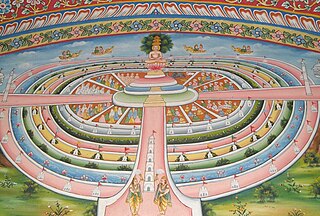
In Jainism, Samavasarana or Samosharana is the divine preaching hall of the Tirthankara, stated to have more than 20,000 stairs in it. The word samavasarana is derived from two words, sama, meaning general and avasara, meaning opportunity. It is an important feature in Jain art. The Samavasarana seems to have replaced the original Jain stupa as an object of worship.

King Nabhi or Nabhi Rai was the 14th or the last Kulakara of avasarpini. He was the father of Rishabhanatha, the first tirthankara of present avasarpini. According to Jain text Ādi purāṇa, Nabhirāja lived for 1 crore purva and his height was 525 dhanusha.
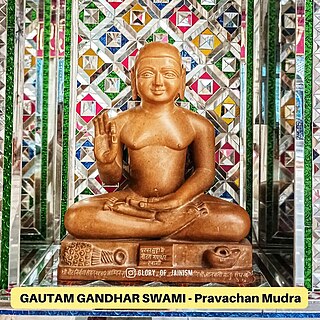
In Jainism, the term Ganadhara is used to refer the chief disciple of a Tirthankara. In samavasarana, the Tīrthankara sat on a throne without touching it. Around, the Tīrthankara sits the Ganadharas. According to Digambara tradition, only a disciple of exceptional brilliance and accomplishment (riddhi) is able to fully assimilate, without doubt, delusion, or misapprehension, the anekanta teachings of a Tirthankara. The presence of such a disciple is mandatory in the samavasarana before Tirthankara delivers his sermons. Ganadhara interpret and mediate to other people the divine sound (divyadhwani) which the Jains claim emanates from Tirthankara's body when he preaches.

Guṇasthāna are the fourteen stages of spiritual development and growth through which a soul gradually passes before it attains moksha (liberation). According to Jainism, it is a state of soul from a complete dependence on karma to the state of complete dissociation from it. Here the word virtue does not mean an ordinary moral quality, but it stands for the nature of soul — knowledge, belief and conduct.

The Four and Twenty Elders Casting their Crowns before the Divine Throne is a pencil drawing and watercolour on paper by the English poet, painter and printmaker William Blake. Created circa 1803–1805, the drawing has been held in London's Tate gallery since 1949. It is likely a visionary and hallucinatory summary of scenes from Chapters 4 and 5 of the Book of Revelation when the throne of God was presented to the prophet Saint John the Divine.
Asrava is one of the tattva or the fundamental reality of the world as per the Jain philosophy. It refers to the influence of body and mind causing the soul to generate karma.
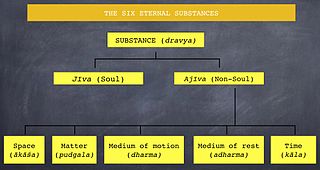
Dravya means substance or entity. According to the Jain philosophy, the universe is made up of six eternal substances: sentient beings or souls (jīva), non-sentient substance or matter (pudgala), principle of motion (dharma), the principle of rest (adharma), space (ākāśa) and time (kāla). The latter five are united as the ajiva. As per the Sanskrit etymology, dravya means substances or entity, but it may also mean real or fundamental categories.

In Jainism, Bharata was the first chakravartin of Avasarpini. He was the eldest son of Rishabhanatha, the first tirthankara. He had two sons from his chief-queen Subhadra, Arkakirti and Marichi. He is said to have conquered all six parts of the world and to have engaged in a fight with Bahubali, his brother, to conquer the last remaining city of the world.

Champat Rai Jain was a Digambara Jain born in Delhi and who studied and practised law in England. He became an influential Jainism scholar and comparative religion writer between 1910s and 1930s who translated and interpreted Digambara texts. In early 1920s, he became religiously active in India and published essays and articles defending Jainism against misrepresentations by colonial era Christian missionaries, contrasting Jainism and Christianity. He founded Akhil Bharatvarsiya Digambara Jain Parisad in 1923 with the aim of activist reforms and uniting the south Indian and north Indian Digambara community. He visited various European countries to give lectures on Jainism. He was conferred with the title Vidya-Varidhi by Bharata Dharma Mahamandal.

Samantabhadra was a Digambara acharya who lived about the later part of the second century CE. He was a proponent of the Jaina doctrine of Anekantavada. The Ratnakaranda śrāvakācāra is the most popular work of Samantabhadra. Samantabhadra lived after Umaswami but before Pujyapada.
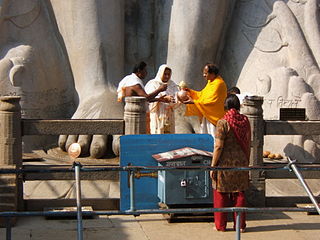
In Jainism, the word Śrāvaka or Sāvaga is used to refer to the Jain laity (householders). The word śrāvaka has its roots in the word śrāvana, i.e. the one who listens.
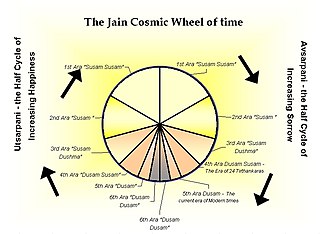
Avasarpiṇī is the descending half of the cosmic time cycle in Jainism and the one in which the world is said to be at present. According to Jain texts the Avasarpiṇī is marked by a decline in goodness and religion. The ascending half of the cycle is called utsarpiṇī, which is marked by the ascent of goodness and religion.
In Jainism, kulakara refers to the wise men who teach people how to perform the laborious activities for survival. According to Jain Cosmology, when the third ara (epoch) of the avasarpani was nearing its end, felicities due to ten type of Kalpavriksha started declining. The number of the sages who thus appeared is said to be fourteen, the last of whom was Nabhirai, the father of the first tirthankara, Rishabhanatha.
















